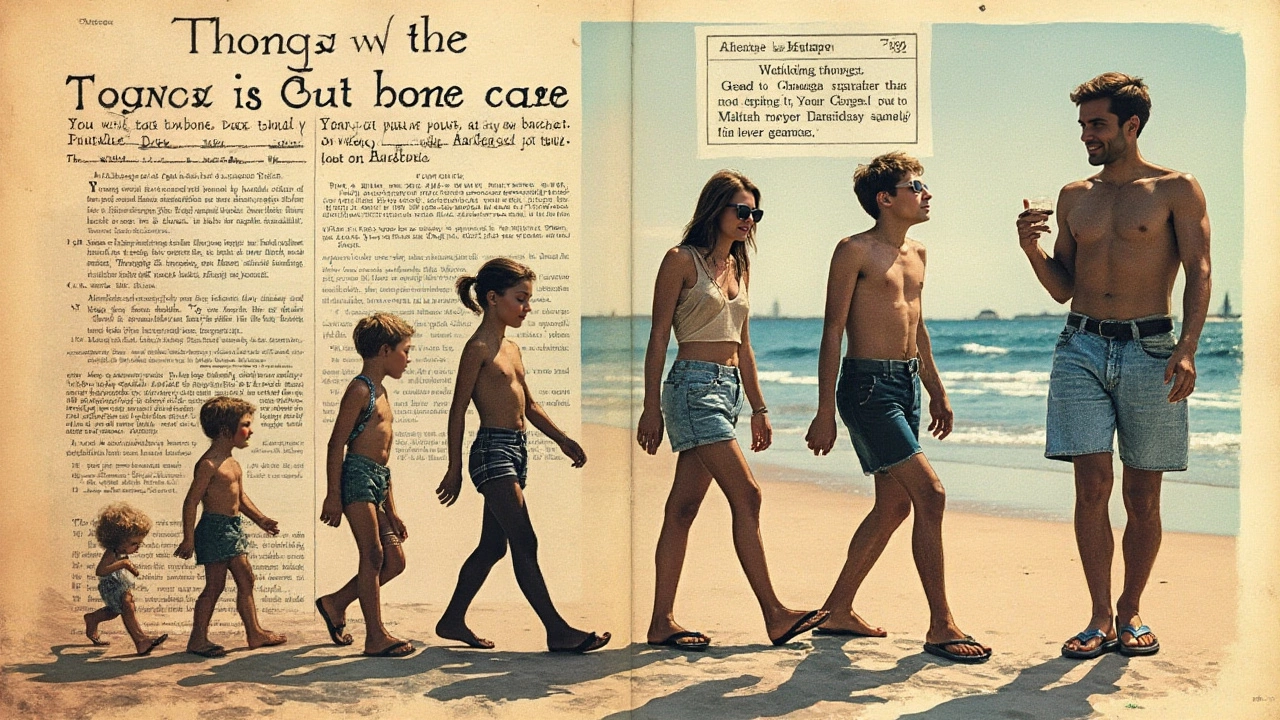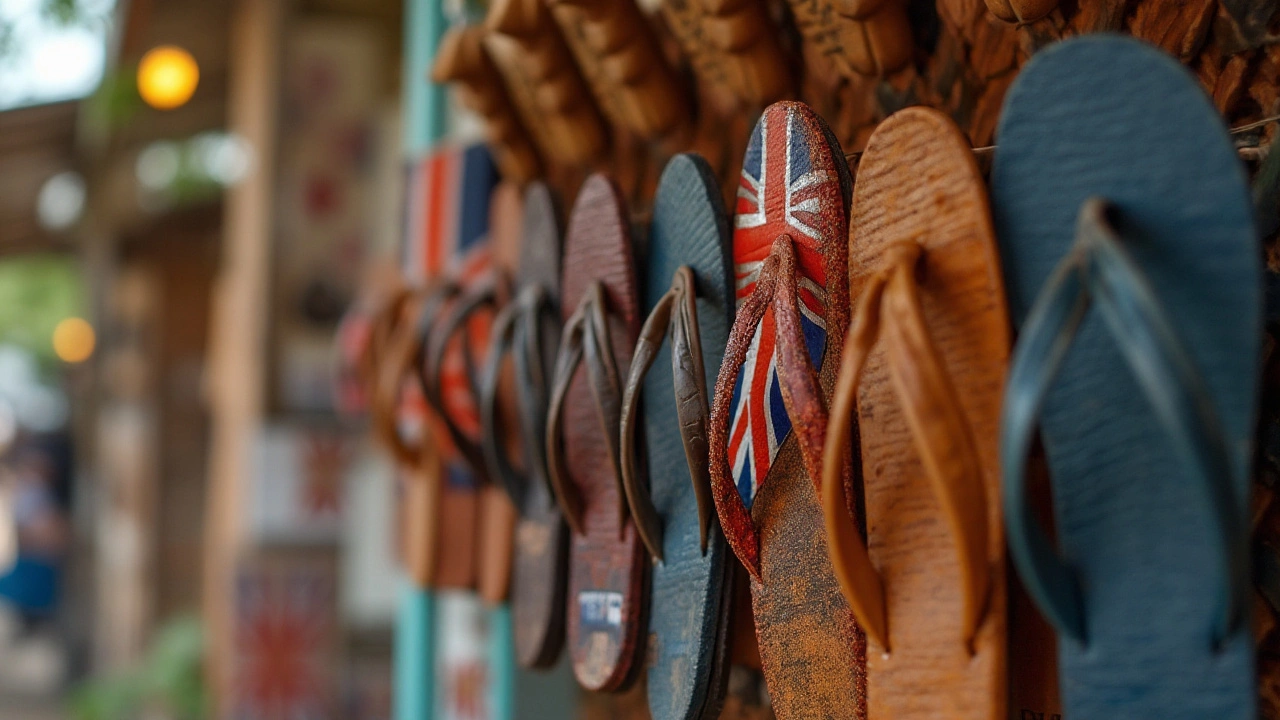Why Aussies Call Flip-Flops 'Thongs' and More About This Footwear Phenomenon

When you hear the term 'thong,' your mind may wander toward undergarments, especially if you're not from Australia. Here in the Land Down Under, however, it's a proud part of our footwear vocabulary, denoting what many around the world recognize as flip-flops. This quirky twist of language serves as a subtle emblem of Australian ingenuity and our unique take on the English language.
The story of thongs in Australia is interwoven with stories of beach life, comfort, and an enduring casual essence. But why do Aussies shy away from the term flip-flops, instead embracing thongs? To understand this linguistic choice, we need to dive into the origins and history surrounding these simple yet essential items in every Aussie wardrobe. From there, we'll journey across states and territories to see how the use of 'thong' compares to other colloquial terms splattered across the globe.
- Historical Background of the Aussie Thong
- Cultural Significance in Australia
- Why Thongs and Not Flip-Flops
- Regional Terms and Varieties
- Choosing the Perfect Pair
- Thongs in Global Pop Culture
Historical Background of the Aussie Thong
Diving into the history of the Aussie thong reveals a fascinating journey quite unlike anything you might expect. While many might associate thongs with sun-drenched beaches and casual Australian lifestyle, their origins are surprisingly global and historic. The earliest known versions of this simple footwear date back thousands of years, with records showing similar thong-style sandals in ancient Egyptian murals. The design was functional enough to ensure coolness in hot climates and easy production using available materials.
Fast forward to the 20th century, and the modern thong came into its own, thanks largely to cultural exchanges following World War II. Returning soldiers brought home a Japanese version of this footwear called the ‘zori’, which sparked interest and innovation both in design and material. By the 1950s, these were being manufactured from rubber, providing a durable, cost-effective option for beachgoers everywhere. In Australia, the term 'thong' began to engrain itself firmly in the vernacular, as locally made versions became immensely popular during the post-war boom.
Evolution and Adoption in Australia
The incredible adaptability of the thong was a key factor in its widespread adoption across Australia. Not only were they perfect for the sandy stretches of coastline, but they were also surprisingly versatile for a range of climates and activities. It didn’t take long for thongs to become a symbol of laid-back Australian culture, particularly through the 60s and 70s. By the 1980s, they'd become an iconic summer staple for countless Australians, a trend cemented by local brands such as Dunlop making them a part of everyday life for all ages.
Local legend claims that the distinctive name came about simply because 'thong' is the Australian word for a type of strap. This aligns with similar naming conventions in Aussie English, where practicality and simplicity are prized. Seemingly, it’s this no-fuss appeal coupled with the quirky twist of humor that helped thongs step into the heart of Australian identity. A 1997 study revealed that Australians on average own three pairs tucked away in their wardrobes, affirming their role as a household essential.
One local historian quipped, "To understand why Australians love their thongs, you only need to feel the sand through a pair on a fine summer’s day."
Whether it’s for popping down to the shops, hitting the beach, or just lounging in the backyard with a 'barbie', thongs represent more than just footwear. They embody a sense of freedom and comfort that reflects the broader national character. Today, while styles and materials have evolved significantly with fashion trends, the basic essence of the Aussie thong has remained steadfast, continuing to hold its ground both locally and to a growing international audience who have embraced this quintessentially Australian oddity.
Cultural Significance in Australia
Thongs in Australia are more than just footwear; they serve as a cultural icon representing the laid-back, sun-drenched lifestyle the country is famous for. Constructed of simple rubber and often sporting vibrant designs, thongs are synonymous with Australian summers. They are an integral part of an ensemble that includes swimmers, board shorts, and wide-brimmed hats, perfectly suited for the beach-loving spirit that resides in every corner of the continent. Wearing thongs isn't just about comfort—it's a statement about embracing nature and simplicity, allowing Aussies to traverse the sandy, rocky, and bushy terrains with ease.
Thongs have also become a subject of humor and endearment in Australian culture, making their presence felt in everyday life. They round off summer barbecues, often acting as faithful companions during trips to the outback or gardening sessions in sprawling backyards. Their economic and practical nature means they are accessible to all, echoing the Australian values of egalitarianism. In a landscape where climate dictates lifestyle, the thong is a year-round affair, only switching up for marginally thicker soles during winter months. As famously quoted by Australian fashion consultant Jonathan Ward,
"The thong epitomizes the Australian love for uncomplicated style and utility, woven inseparably into the national fabric."
Furthermore, thongs have even ventured into the sphere of competitive events. The Blow-Up Thong race along the mighty Clarence River in Grafton has become an annual spectacle, bringing communities together for a peculiar yet entertaining race featuring giant inflatable thongs. This event is a testament to how deeply embedded this quaint piece of footwear is in the Australian psyche. While region-specific attributes exist, from New South Wales' penchant for colorful pairs to Queensland's love for swapping them with flip-flops every now and then during their tropical rains, the thong maintains its honored place.
The love for thongs has not waned even as the fashion industry continues to evolve, with Australian designers incorporating them into high fashion and tailor-made accessories. Whether it be casual outings or beach weddings, the versatility of thongs in Australia is unparalleled. In terms of statistics, a survey revealed that over 85% of Australians own at least one pair of thongs, often with multiple pairs to account for different occasions and needs. As these humble slippers continue to leave their footprint on Australian soil, it's clear that they hold a transcultural appeal, underscoring a national identity marked by resilience and simplicity.

Why Thongs and Not Flip-Flops
One of the quirkiest aspects of Australian English is its knack for reshaping words familiar to other English-speaking cultures. The term 'thongs' as it applies to what many know as 'flip-flops' is a splendid example of this linguistic twist. Tracing back through the annals of language, the word 'thong' dates way back to Old English as 'thwang,' a term for a flexible leather strap. This origin makes sense when you consider the strap that holds these sturdy, yet lightweight, sandals to your feet. And while Aussies have embraced 'thong' primarily to mean these footwear essentials, the word also connotes, within a broader context, the thong sandals' thin binding straps. It's a testament to linguistic evolution and regional adaptability.
The choice to use 'thongs' as opposed to 'flip-flops' in Australia likely burgeoned due to cultural exchanges and Australia's unique embrace of beach-centric lifestyle. Flip-flops, as they are known internationally, find their name in the sound they make against your heel as you meander. Yet, Australians prefer to distill the item to its core component — its defining straps, which are succinctly captured in the term 'thong.' Ralph Waldo Emerson once writ, "Language is the archives of history." In that spirit, the Australian designation 'thong' serves as a linguistic emblem of a nation perfectly adapting English history to its shores, a unique lexicon for a laid-back way of life.
Adding yet another layer, this term has also carved its way into Australian identity through the local love affair with brevity. Aussies have a penchant for shortening words — afternoon becomes 'arvo,' and everything gets a nickname — 'barbie' instead of barbecue or 'brekkie' over breakfast. Thongs found their place in linguistic traditions not just through historical provenance but through sheer ease of articulation and the Aussie love for distinct expression. It mirrors how these sandals slide seamlessly into everyday wear, forming an indelible part of daily Australian life. When you picture an Aussie, especially at the beach, you picture bare feet casually tucked into a pair of thongs.
Often this term sparks amusing misunderstandings with international visitors. Such anecdotes illuminate the cultural richness woven into a single word. The Australian McPherson family recalls a hilarious incident where they invited American friends over for a “thong party,” drawing laughter and a bit of bewilderment. It wasn't until they arrived that the friends discerned the complete context, resulting in riotous laughter. Language, after all, offers not only communication but a way of sharing — sometimes in the form of chuckles.
Regional Terms and Varieties
Australia is a vast country with a rich tapestry of dialects and regional expressions, and the term "thongs" is a prime example of this linguistic diversity. While most Australians will immediately recognize thongs as a type of sandal, the term isn't universally understood elsewhere, where 'thong' might elicit laughs or puzzled looks due to its connotations with undergarments. Within Australia, the term consistently refers to the same type of footwear, yet some variations arise based on region, heritage, and even climate.
In the broad coastal landscapes of Queensland, thongs are an essential part of everyday life, accompanying locals to the beach, shopping, or merely enjoying a starlit barbecue. The same holds true in New South Wales and Victoria, where these lightweight and versatile sandals make perfect sense for a climate that can change from sunny to rainy in minutes. However, in the cooler climates of Tasmania, you might find fewer people wearing them during winter months, turning to sturdier alternatives. Yet, the love for thongs remains unshaken, with devotees joking that they can endure anything—even a chilly morning breeze.
The uniqueness extends to other regions as well. Western Australia offers a testament to thongs' robust character; here, they're seen as little warriors against scorching pavements. The Kimberley builders and miners may wear more durable, closed footwear but will often switch to thongs after-hours as an ode to freedom and relaxation from the confines of steel-capped boots. There's an interesting linguistic quirk found in rural communities who sometimes humorously refer to thongs as "pluggers"—a nod to the plug or peg that holds the sandal together.
Expanding beyond Australia, we have a glorious mishmash of terms that include "flip-flops," "slippers," and "slides," each representing a different style of this open-toed footwear. The United States, for instance, leans heavily towards "flip-flops," reflecting the characteristic sound they make. Traveling to New Zealand, one might encounter "jandals," a portmanteau for Japanese sandals, while in the UK, "sliders" are a more common nomenclature in fashion and beachwear.
To illustrate this diversity, let's look at a comparative chart:
| Country | Common Term |
|---|---|
| Australia | Thongs |
| USA | Flip-flops |
| New Zealand | Jandals |
| UK | Sliders |
"It's a beauty of linguistics that a single item can have so many names and meanings across cultures," says Dr. Lisa Harper, a renowned linguist from the University of Melbourne. "In Australia, thongs are not merely about function, but a cultural identity represented through everyday wear."
The world of thongs continues to evolve, adapting new styles and materials while remaining a steadfast companion to those who love the casual life. As travelers come and go, bringing with them tales of what thongs mean in their countries, Australia will undoubtedly continue to champion this simple yet iconic piece in its own laid-back style.

Choosing the Perfect Pair
When it comes to picking the perfect pair of thongs, Australians have a knack for selecting styles that offer both comfort and durability. In a country where people can bask in the sun for most of the year, thongs are more than just a casual footwear choice—they’re practically a seasonal uniform. But not all thongs are created equal, and there are several factors to consider to ensure you're selecting the best pair for your feet.
First and foremost, consider the material. Poor-quality thongs can lead to discomfort, so many Aussies prefer styles made from rubber or EVA foam for their cushioning properties. These materials are lightweight, flexible, and water-resistant, which makes them perfect for beach outings or poolside lounging. In recent years, eco-friendly options using recycled or sustainable materials have gained popularity, offering both style and peace of mind to environmentally-conscious consumers.
Size and fit are equally crucial, as choosing a pair that’s either too tight or too loose can result in blisters or awkward walking. A good fit should allow for some space between the edge of the sole and your heel, ensuring your feet move naturally.
Thongs in Global Pop Culture
Thongs, known globally as flip-flops, have transcended their humble beginnings to become cultural icons in their own right. These simple shoes have etched their presence not only in the daily lives of beach-goers but also in entertainment industries around the world. Reminiscent of an endless summer, thongs have been featured prominently in movies, music videos, and fashion runways, each time shining a spotlight on their symbolic connection to relaxation and ease. In the cinematic world, thongs frequently appear in films set in tropical locales or those that aim to capture a bohemian lifestyle. One has to merely think of movies like "Blue Crush" or "The Beach," where characters wearing thongs are often portrayed as carefree spirits, embodying the quintessential laid-back attitude.
Stepping beyond the big screen, the fashion industry has had its flirtations with thongs. Designers have taken this ubiquitous piece of footwear and elevated it into high fashion status. Thongs have sashayed down runways, with designers adding embellishments or innovative materials to create them anew. For instance, brands in the late 90s and early 2000s embraced thongs in their collections, reflecting a surge in relaxed, resort-style fashion. This period marked a renewed interest in leisurely wear, where comfort started seamlessly blending with high fashion. The footwear became a statement of ease, style, and freedom.
In the realm of music, thongs have also danced their way into lyrics and visuals. From beach-themed music videos to pop stars embracing them during their off-days, these shoes represent a sense of playfulness and rebellion against conventional fashion norms. A well-known incident in pop culture occurred when Rihanna sported a plush pair of thongs during a global beach campaign, spotlighting their continual relevance and ubiquity even among celebrities known for shaping fashion trends. More than just footwear, thongs have often embodied a love for simplicity and a rebellion against restrictive fashion.
Their reach in pop culture isn't without its quirks and critiques, however. Some argue that despite their comfort, thongs often lack support, leading to debates about their practicality versus style. Yet, despite critiques, their place in history as a powerful symbol of nonchalance remains, almost challenging society’s preoccupation with complexity and formality. It's fascinating to consider how these shoes, so minimal in design, have persistently echoed through time and culture.
Thongs illustrate, more than anything, our enduring love affair with style that does not compromise on comfort and ease, a sentiment echoed by renowned fashion historian Emma Baxter-Wright.
- Dec, 18 2024
- Violet Greenfield
- 0
- Permalink
Written by Violet Greenfield
View all posts by: Violet Greenfield